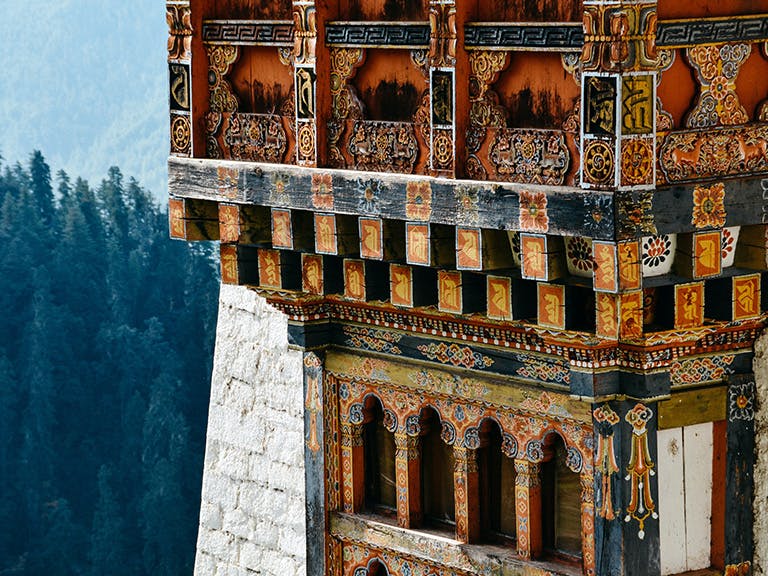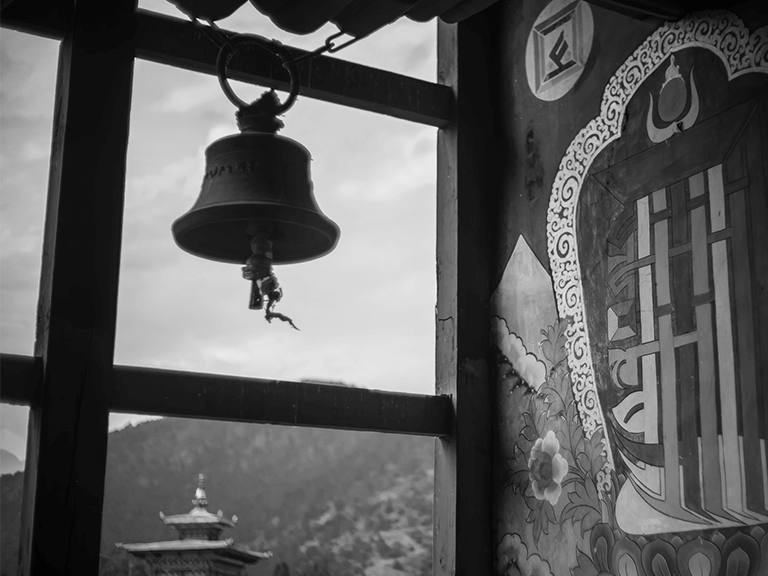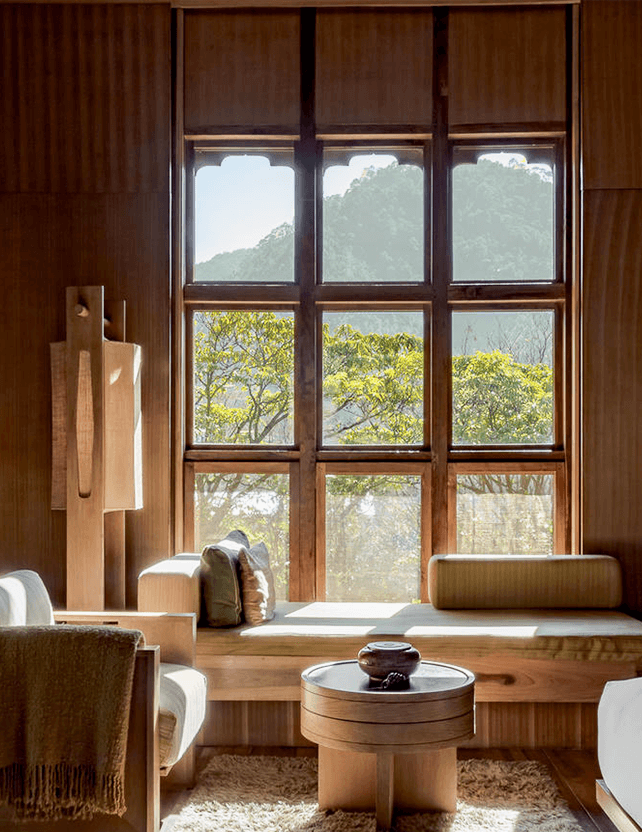
Loading...
BHUTAN: EXPLORING THE GREAT WILDERNESS
Bhutan
CONSERVING THE KINGDOM'S BIODIVERSITY
Cradled in the eastern Himalaya, Bhutan is recognised as the world’s first carbon-negative country. On this journey, explore the protected wilderness to discover the communities that nurture planetary health and personal happiness above material growth. Accompanied by leading Bhutanese conservationists, hike hidden valleys to track rare flora and fauna, and explore how Bhutan’s Buddhist principles have informed its environmental programmes.
Can Bhutan’s earth-conscious approach be a blueprint for global environmental conservation?


DAY 1 - GROUNDING IN NEPAL
Arriving in Kathmandu, Nepal, transfer to Dwarika’s Hotel, a heritage-minded property that seamlessly blends salvaged Newari wood carvings into its design. Engage with Nepal’s profound spirituality at the Boudhanath Stupa, where Buddhist worshippers perform the kora. In the evening, travel to the Hindu temple of Pashupatinath, taking part in a sunset ceremony of fire and rhythmic chanting – also known as the Aarti Ritual. The day concludes with a slow-dining Nepalese banquet of freshly harvested vegetables, grains and spices sourced from Dwarika’s own organic farms.

DAY 2 - EVEREST FROM ABOVE
The morning flight to Paro passes the legendary summit of Mount Everest, presenting unparalleled vistas of the Great Himalaya Range – cloud-cover permitting. After rooting on terra firma, discover a traditional Bhutanese town of whitewashed farmhouses and staggering willow trees. From there, travel to the 52m-tall statue of the Great Buddha Dordenma, a symbolic guard of entry to the Thimphu Valley. Later that evening, join the founder of Bhutan’s Royal Society for the Protection of Nature, Dasho Benji, for an intimate dinner. Often regarded as the Godfather of Conservation in Bhutan, discuss his landmark work to conserve the endangered, black-necked cranes, for which the Kingdom is renowned. The Six Senses Lodge is home for the night.

DAY 3 - INTO THE PHOBJIKHA VALLEY
Following a leisurely breakfast, journey east over the dense Dochu La mountain pass to the Phobjikha Valley. Considered one of the most important wildlife preserves in the country, it’s in this bowl-shaped glacial cirque that Bhutan’s black-necked cranes return every autumn from Tibet, a migration that heralds the end of harvest and inspires celebration among farming families. Arrive at the 12-room Gangtey Lodge, a rural retreat with sweeping views across the valley. Unwind with a special dinner prepared by the head chef.

DAY 4 - NATURE IN BALANCE
Join one of Bhutan’s most influential naturalists Dr Sherub Sherub, on a variety of research hikes deep in the Phobjikha Valley. Explore the profound synergy between species of the eastern Himalayas, supporting Sherub in his fieldwork with birds, in particular several species of raptor. Why are vultures, once critically endangered, so vital to the ecosystem of the valley?

DAY 5 - BHUTAN BY WATER
Experience morning prayers in a Shedra (monastic college), before descending to the fertile valley of Punakha. Resting at the mouth of the Mo Chhu (Mother River), join a team of researchers from the National Invertebrate Program to take to the waters by raft to assist in compiling an inventory of aquatic biodiversity. Recent findings uncovered a new species of dragonfly – what new discoveries await? Come sunset, put ashore at a tented river lodge for drinks, dinner and relaxation.

DAY 6 - WILD ORCHIDS AND TIGERS
Travel to a remote and scenic organic farm and join Sangay Richen, a passionate eco-farmer, on a foraging expedition in the forests, in search of food including edible wild orchids. Later, join Dr Tiger Sangay, a charismatic Bhutanese researcher at the Ugyen Wangchuck Institute for Conservation and Environment Research, to monitor camera traps tracking the movements of Bengal Tigers. Return to the Farm and share the day’s findings. Enjoy a traditional Bhutanese meal prepared with the forest’s bounty and served in a stunning setting overlooking the mountain terraces.

DAY 7 - PRIMEVAL FORESTS OF PARO
Returning West to Paro, explore biodiverse woodland and plant tree saplings with Sonam Phuntsho – Director for Research and Education at the Bhutan Ecological Society and a forestry expert who is studying the impact of climate change. By law, at least 60 per cent of Bhutan’s landscape must remain forested for future generations, a mandate which has helped Bhutan become the first nation to achieve not only carbon-negative status, but to absorb triple the carbon it produces. Learn how the presence of forests helps regulate rainfall, which in turn supports farming communities. In the evening, an organic meal at farm-to-fork restaurant Bukhari awaits.
"FORESTS ARE A SOURCE OF LIVELIHOOD FOR MANY, AND EVEN FOR MICROCLIMATIC CONDITIONS, THE FOREST IS WHAT CONTROLS PRECIPITATION. THE MORE FOREST YOU HAVE, YOU'LL HAVE MORE REGULAR PRECIPITATION, SO THAT HELPS FARMING COMMUNITIES."
– SONAM PHUNTSHO

DAY 8 - PRAYER FLAGS AND HOT STONES
Hike the pine-flanked trails to the remarkable Taktshang Goemba, known as the Tiger’s Nest Monastery, or alternatively, visit the lesser-known 9th-century Kila Nunnery. There, join locals as they raise prayer flags, appreciating the stillness and tranquillity of the nature-rich environment. Recharge with a scenic picnic lunch, before indulging with Uma Paro's signature hot stone bath infused with medicinal herbs. End the journey with a lantern-lit dinner held in the charming courtyard of the property's off-grid lodge.

DAY 9 - DEPARTURE
Depart from Paro to Kathmandu or Delhi.
RECOMMENDED STAYS
From sumptuous mountain retreats to luxurious stays reimagining Bhutanese interiors, discover recommended addresses for this journey.
FROM £16,990 PER PERSON
For nine days, based on two people sharing.
INCLUSIONS
Private dinner with expert environmentalist Dashjo Benji, considered the Godfather of Conservation
A guided research hike through the Phobjika Vallery with farmer Dr Sherub Sherub
Exploration of the legendary Mo Chhu River by raft
Tiger tracking with researcher Dr Tiger Sangay
Visit of the UNESCO-protected Boudhanath Stupa – the largest spherical stupa in Nepal
Foraging for wild edible orchards with expert farmer Sangay Rinchen
Private farm-to-fork dinner at Krishnarpan restaurant sourced from Dwakira’s organic farms
Guided forestry exploration with tree planter, Sonam Phuntsho, discovering the country's carbon-negative status
Airport transfers and local transfers to activities and meals as mentioned
Entrance fees and guided tours with English-speaking experts and guides
Guided visit to the Great Buddha Dordenma Statue
Visit to the iconic Taktsang Monastery (Tiger’s Nest)
Hot stone bath at Como, a treatment renowned for its health benefits
ACCOMMODATION INCLUDED
One nights’ accommodation at The Dwarika’s Hotel Kathmandu in a heritage deluxe bedroom
One nights’ accommodation at Six Senses Thimphu in an Upper lodge suite
Two nights’ accommodation at Gangtey Lodge in a suite
Two nights’ accommodation at Punakha River Lodge in a tented suite
Two nights’ accommodation at Uma Paro in a one-bedroom villa
WHEN TO TRAVEL
The best time to travel is between October – November 2023 and February to April 2024.
EXCLUSIONS
Excursions, meals and drinks other than those mentioned
A flight over the Mount Everest summit from Kathmandu in Nepal to Paro in Bhutan
Sustainable Developmental Charge to the Tourism Council
Travel insurance and vaccination charges
THE EXPERT
SANGAY RINCHEN
Join Sangay Rinchen – innovator of transforming Bhutan's farming systems – to learn how to source food sensitively in harmony with nature and the surrounding local communities. Sangay is also the face behind Happy Hill Farm, an initiative that uses technology and regenerative farming practices to encourage sustainable living.






